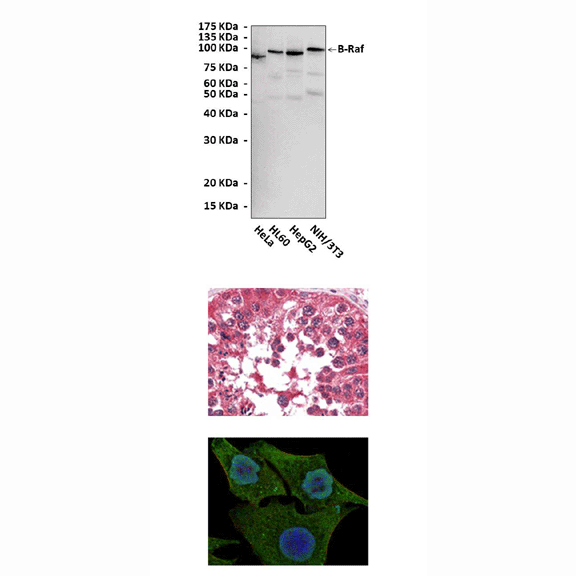Product Sheet CP10027
Description
BACKGROUND The RAF protein kinases family contains three serine/threonine kinases including A-RAF, B-RAF, and C-RAF. They share three conserved regions: CR1 and CR2 within the regulatory NH2 terminus and CR3 encompassing the kinase domain within the COOH terminus. They are part of the ras-MAPK signaling cascade and phosphorylate MEK.1 RAF proteins are normally cytosolic but they are recruited to the plasma membrane by the small G-protein RAS, and this is an essential step for their activation by growth factors, cytokines, and hormones. At the membrane, RAF activation occurs through a highly complex process involving conformation changes, binding to other proteins, binding to lipids, and phosphorylation and dephosphorylation of some residues. This activation process is tightly regulated by a number of factors including phosphatases (e.g. PP1, PP2A,PP5), kinases (e.g. Src, ERK, Akt, PKC) and proteins that bind directly to Raf-1 (e.g. RKIP, 14-3-3zeta, KSR, Hsp90). Within the kinase domain, phosphorylation of two motifs is required for activation. One of these is called the activation segment, which must be phosphorylated on conserved threonine and serine residues (In B-RAF, these are T599 and S602, and in C-RAF, the corresponding residues are T491 and S494). The other motif that must be phosphorylated is called the negative-charge regulatory or N-region. In C-RAF, the N-region sequence is 338SSY341Y and phosphorylation of S338 and Y341 is essential for activation by RAS and growth factors. Both sites are conserved in A-RAF (S299 and T302, respectively) but in B-RAF, Y340 and Y341 are replaced by aspartic acids (D448 and D449) and although S338 is conserved, it is constitutively phosphorylated. All RAF isoforms are only fully activated when four negative charges occupy the region.2 Thr401 phosphorylation was induced by PDGF stimulation.3
B-RAf is commonly mutated and thereby activated in many human cancers, the most frequent mutation being the V600E mutation of the kinase domain. Whilst wt B-RAF and Raf-1 are strongly activated by growth factor signals via Ras and Src, A-RAF is only modestly activated and has low basal activity. All three isoforms of Raf are considered to be oncogenic.4
REFERENCES
1. Wan, P.T. et al: Cell 116:855-67, 2004
2. Morrison, D.K. & Cutler, Jr, R.E.: Curr. Opin. Cell Biol. 9:174-9, 1997
3. Ritt, D.A. et al: Mol. Cell Biol. 30:806-19, 2010
4. Dhillon, A.S. & Kolch, W.: Cancer Cell 5:303-4, 2004
2. Morrison, D.K. & Cutler, Jr, R.E.: Curr. Opin. Cell Biol. 9:174-9, 1997
3. Ritt, D.A. et al: Mol. Cell Biol. 30:806-19, 2010
4. Dhillon, A.S. & Kolch, W.: Cancer Cell 5:303-4, 2004
Products are for research use only. They are not intended for human, animal, or diagnostic applications.
Details
Cat.No.: | CP10027 |
Antigen: | Purified recombinant human B-RAF protein fragments expressed in E. coli. |
Isotype: | Mouse IgG1 |
Species & predicted species cross- reactivity ( ): | Human, Mouse |
Applications & Suggested starting dilutions:* | WB 1:500 - 1:2000 IP n/d IHC 1:200 - 1:1000 ICC 1:200 - 1:1000 FACS n/d |
Predicted Molecular Weight of protein: | 94 kDa |
Specificity/Sensitivity: | Detects endogenous B-RAF proteins without cross-reactivity with other family members. |
Storage: | Store at -20°C, 4°C for frequent use. Avoid repeated freeze-thaw cycles. |
*Optimal working dilutions must be determined by end user.
Products
| Product | Size | CAT.# | Price | Quantity |
|---|---|---|---|---|
| Mouse B-Raf Antibody: Mouse B-Raf Antibody | Size: 100 ul | CAT.#: CP10027 | Price: $531.00 |

